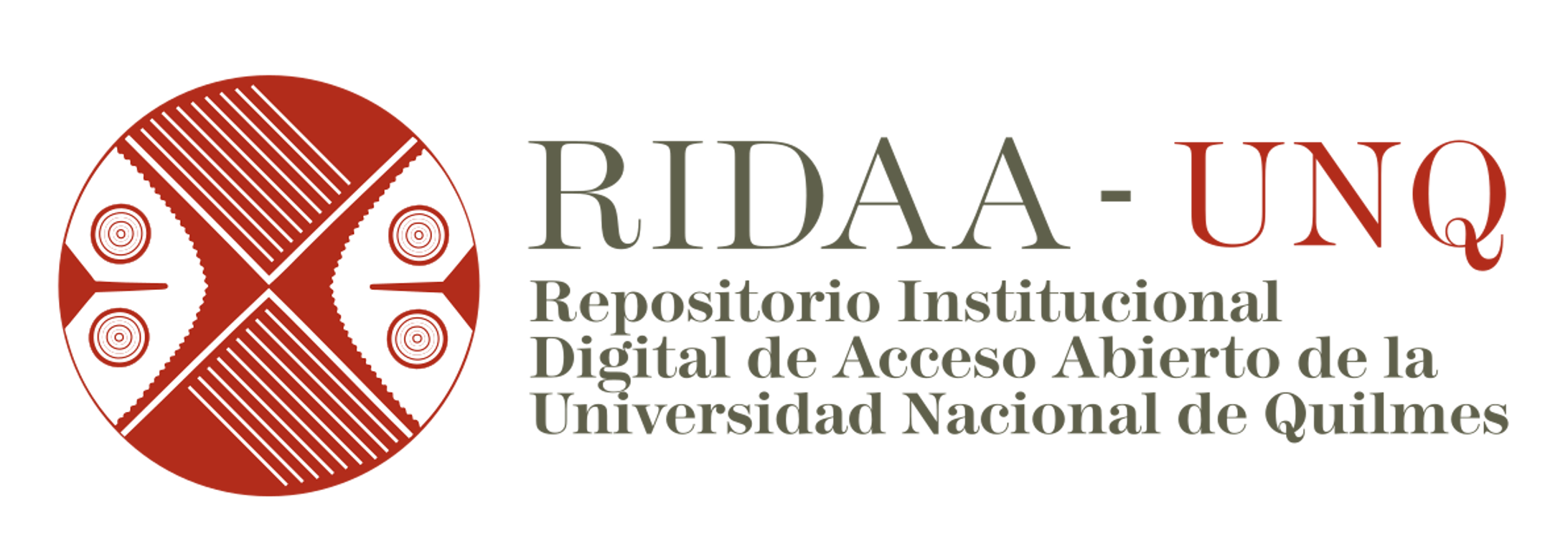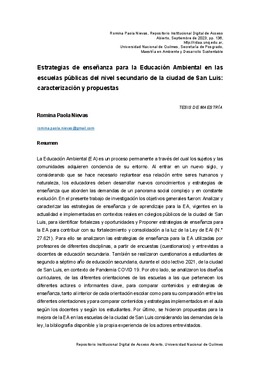Mostrar el registro sencillo del ítem
Estrategias de enseñanza para la educación ambiental en las escuelas públicas del nivel secundario de la ciudad de San Luis : caracterización y propuestas
| dc.creator | Nievas, Romina Paola | |
| dc.date | 2023-02-05 | |
| dc.date.accessioned | 2024-02-06T13:31:54Z | |
| dc.date.available | 2024-02-06T13:31:54Z | |
| dc.date.issued | 2023-09-07 | |
| dc.identifier.citation | Nievas, R. P. (2023). Estrategias de enseñanza para la educación ambiental en las escuelas públicas del nivel secundario de la ciudad de San Luis: caracterización y propuestas. (Tesis de maestría). Universidad Nacional de Quilmes, Bernal, Argentina. | es |
| dc.identifier.uri | http://ridaa.unq.edu.ar/handle/20.500.11807/4232 | |
| dc.description | Fil: Nievas, Romina Paola. Universidad Nacional de San Luis; Argentina. | es |
| dc.description.abstract | La Educación Ambiental (EA) es un proceso permanente a través del cual los sujetos y las comunidades adquieren conciencia de su entorno. Al entrar en un nuevo siglo, y considerando que se hace necesario replantear esa relación entre seres humanos y naturaleza, los educadores deben desarrollar nuevos conocimientos y estrategias de enseñanza que aborden las demandas de un panorama social complejo y en constante evolución. En el presente trabajo de investigación los objetivos generales fueron: Analizar y caracterizar las estrategias de enseñanza y de aprendizaje para la EA, vigentes en la actualidad e implementadas en contextos reales en colegios públicos de la ciudad de San Luis, para identificar fortalezas y oportunidades y Proponer estrategias de enseñanza para la EA para contribuir con su fortalecimiento y consolidación a la luz de la Ley de EAI (N.° 27.621). Para ello se analizaron las estrategias de enseñanza para la EA utilizadas por profesores de diferentes disciplinas, a partir de encuestas (cuestionarios) y entrevistas a docentes de educación secundaria. También se realizaron cuestionarios a estudiantes de segundo a séptimo año de educación secundaria, durante el ciclo lectivo 2021, de la ciudad de San Luis, en contexto de Pandemia COVID 19. Por otro lado, se analizaron los diseños curriculares, de las diferentes orientaciones de las escuelas a las que pertenecen los diferentes actores o informantes clave, para comparar contenidos y estrategias de enseñanza, tanto al interior de cada orientación escolar como para su comparación entre las diferentes orientaciones y para comparar contenidos y estrategias implementados en el aula según los docentes y según los estudiantes. Por último, se hicieron propuestas para la mejora de la EA en las escuelas de la ciudad de San Luis considerando las demandas de la ley, la bibliografía disponible y la propia experiencia de los actores entrevistados. En las escuelas de la ciudad de San Luis, la EA, en general, forma parte de los Proyectos Educativos Institucionales (PEI) y en el ámbito áulico los profesores comentan que utilizan diversas estrategias de enseñanza, pero en el análisis de los datos obtenidos en este trabajo, la mayoría de ellas son más bien teóricas tales como: observar videos, leer textos de diferentes estilos, debatir, analizar leyes, dialogar, etc. Reconocen que es importante realizar actividades al aire libre, como salidas de campo o actividades en terreno, pero justifican que muchas de estas actividades no se concretan por la burocracia de la gestión para salidas escolares. Entre las limitaciones reconocidas se destaca el propio desinterés de los docentes y el escaso tiempo áulico de que se dispone. Pese a ello, están predispuestos a incluir sus propios hábitos pro ambientales en sus planificaciones áulicas con fundamento desde la teoría. Además, valoran la importancia de capacitarse, de tomar cursos y disponer de bibliografía para aplicarla y adecuarla a su disciplina. Están abiertos a incluir a las familias y proponen trabajar la EA de manera transversal. Es de destacar que muy pocas respuestas involucran la dimensión comunitaria o socio-comunitaria como un aspecto más de la EA, más bien la significan a una temática exclusiva de las ciencias naturales. Respecto a las estrategias de enseñanza que valoran los estudiantes la mayoría remite a las actividades al aire libre o salidas de campo, es decir “aprender haciendo''. Sin duda, este momento post pandemia COVID-19 nos interpela y nos invita a pensar en nuestros estilos de vida y consumo. Es así que resulta indispensable reflexionar en torno a cómo usamos y cómo cuidamos el ambiente. Para ello se hace fundamental una EA integral que revalorice los saberes ancestrales y comunitarios, enseñe a respetar los tiempos de la naturaleza y promueva la reflexión sobre la justicia ambiental, entre otros temas. Por ello, no se debe olvidar la posibilidad de vincular el proceso educativo de la EA a un proyecto de comunidad establecido y en particular, considerar las potencialidades y oportunidades del entorno más cercano a la escuela y a los estudiantes para fortalecerlas, promoverlas y hacerlas más significativas. | es |
| dc.description.abstract | Environmental Education (EE) is a permanent process through which subjects and communities become aware of their environment. As we enter a new century, and considering that it is necessary to rethink the relationship between human beings and nature, the professors must develop new knowledge and teaching strategies that approach to the demands of a complex and constantly evolving social scenery. In this investigation work, the general objectives were: Analyze and characterize the teaching and learning strategies for EE, currently in force and implemented in real contexts in public schools in the city of San Luis, to identify strengths and opportunities and propose strategies for teaching for EE to contribute to its strengthening and consolidation in light of the IEE Law (27,621). For this, the teaching strategies for EE used by teachers from different disciplines were analyzed, based on surveys (questionnaires) and interviews with high school teachers. Questionnaires were also carried out on students from the second to seventh year of high school, during the 2021, in the city of San Luis, in the context of the COVID 19 Pandemic. On the other hand, the curriculum designs of the different school´s orientation to which the different actors belong, to compare content and teaching strategies, both within each school's orientation and for comparison between the different orientations and to compare content and strategies implemented in the classroom according to the teachers and according to the students. Finally, proposals were made for the improvement of EE in the schools of the city of San Luis considering the demands of the law, the available bibliography and the experience of the interviewed actors. In the high schools of the city of San Luis, EE, in general, is part of the Institutional Educational Projects (IEP) and in the classroom, the teachers comment that they use different teaching strategies, but in the analysis of the data obtained in this work, most of them are rather theoretical such as: watching videos, reading texts of different styles, debating, analyzing laws, dialogue, etc. They recognize that it is important to carry out activities in the open air, such as field trips or field activities, but they justify that many of these activities are not carried out by the bureaucracy of management for school trips. Among the recognized limitations, the lack of interest of teachers and the limited classroom time available stand out. Despite this, they are predisposed to include their own pro-environmental habits in their classroom planning based on theory. They also value the importance of training, taking courses and having a bibliography to apply it and adapt it to their discipline. They are open to including families and propose to work on EE in a transversal way. It is noteworthy that very few answers involve the community or socio-community dimension as one more aspect of EE, rather they refer to it as an exclusive theme of the natural sciences. Regarding the teaching strategies that students value, most refer to outdoor activities or field trips, that is, "learning by doing". Undoubtedly, this post-COVID-19 pandemic moment challenges us and invites us to think about our lifestyles and consumption. Thus, it is essential to reflect on how we use and how we care for the environment. For this, a comprehensive EE is essential that revalues ancestral and community knowledge, teaches respect for the times of nature and promotes reflection on environmental justice, among other issues. For this reason, the possibility of linking the EE educational process to an established community project should not be forgotten and, in particular, consider the potentialities and opportunities of the environment closest to the school and the students to strengthen, promote and make them more significant. | en |
| dc.format | application/pdf | es |
| dc.format.extent | 136 p. | es |
| dc.language | spa | es |
| dc.publisher | Universidad Nacional de Quilmes | es |
| dc.rights | https://creativecommons.org/licenses/by-nc-nd/2.5/ar/ | es |
| dc.subject | Educación ambiental | es |
| dc.subject | Enseñanza media | es |
| dc.subject | Métodos pedagógicos | es |
| dc.subject | Diseño curricular | es |
| dc.subject | San Luis (Argentina : Ciudad) | es |
| dc.subject | Environmental education | en |
| dc.subject | Secondary education | en |
| dc.subject | Teaching methods | en |
| dc.subject | Curricular design | en |
| dc.subject | San Luis (Argentine : City) | en |
| dc.subject | Educação ambiental | pt |
| dc.subject | Ensino médio | pt |
| dc.subject | Desenho curricular | pt |
| dc.subject | San Luis (Argentina : Cidade) | pt |
| dc.title | Estrategias de enseñanza para la educación ambiental en las escuelas públicas del nivel secundario de la ciudad de San Luis : caracterización y propuestas | es |
| dc.type | info:ar-repo/semantics/tesis de maestría | es |
| unq.tesis.director | Gil, María Angélica | |
| unq.tesis.codirector | Mir, Graciela | |
| unq.tesis.calificacion | Aprobado-Sobresaliente | es |
| unq.tesis.titulo | Maestría en Ambiente y Desarrollo Sustentable | es |
| unq.tesis.jurado | Marchevsky, Karina | |
| unq.tesis.jurado | García, Pilar | |
| unq.tesis.jurado | Ibáñez, Susana | |
| unq.version | info:eu-repo/semantics/acceptedVersion | en |
| unq.tipo.snrd | info:eu-repo/semantics/masterThesis | en |
| unq.acceso | info:eu-repo/semantics/openAccess | en |
| unq.tesis.acta | 53 | es |
| unq.creador.correo | romina.paola.nievas@gmail.com | es |
Ficheros en el ítem
Este ítem aparece en la(s) siguiente(s) colección(ones)
-
Tesis de posgrado
Tesis doctorales y de maestría

